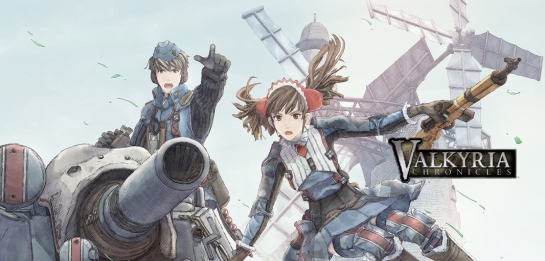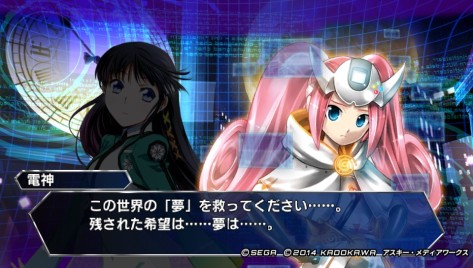
War. We see that all the time in games. But seldom we see war from a different perspective. Valkyrie Chronicles is one of those games which gives some sense : rather than shooting souless avatars or giving orders to micro units, Sega’s game does its best describing the hardhisps of war, the dramatic consequences of ideology, the importance of strategy. A PC version and a remaster later, it has become legendary.

Valkyria Chronicles is a turn based tactical-RPG absolutely unique, partly because it swaps the traditional heroic-fantasy for a military conflict like World War II. It’s a bit like Fire Emblem transposed in 1935. A powerful Empire decides to invade the peaceful principality of Gallia so as to get its abundant resources. The general mobilization is stated and the player takes command of a battalion of 30 characters (the number of soldiers to be deployed varies), everyone having a true personality and a small background. Your men are divided between five classes : Recon, Assault, Mechanic, Anti-tank and Sniper. To that you have to add your own tank which is a unique unit, commanded by Welkin Gunther, the hero of the game. As you might guess, each type of unit has different statistics (HP, evasion, defense, speed, etc.) and its own gameplay. The various roles are varied and it’s up to you to make the best use of their particularities while keeping strategic positions, because any blunder can quickly mean death.

That is a very important aspect of Valkyria Chronicles compared to its PSP sequels : the characters die definitely after 4 turns if their HP is zero, or if an enemy reach them in that state. Like in Fire Emblem, the player feels close to the characters. They have a personality, they have a reason to fight, they have dreams, they have values, they’re not “units” like in a RTS game. The player is sent to war in its true meaning, taking heavy decision in a context of high pressure. But you can save your game anytime, which reduces the challenge.

The missions are nevertheless difficult, and extremely varied. There’s urban warfare, plain warfare, desert warfare, a landing, a large trench battle, sniper confrontation, infiltration and rescue! The Empire, overwhelmingly superior in both men and equipment, leaves no moment for rest. You’ll face artillery fire, mine fields, tank squads, powerful (or even invincible) generals or crazy prototypes. War fog is present and makes the strategy even more immersive. The gap in forces and the feeling of total and merciless war brings tension, but is also very rewarding when you see the victory screen after 1 hour of intense struggle. The war atmosphere is reinforced by the regular transmissions from your buddies or the ones you intercept from the enemy.

The gameplay is actually more complex than in Fire Emblem. Adding to the complexity if coordinating the various specializations, you can call back your characters and mobilize others to fit with your strategy. This can be done from or base camp or intermediate bases to take from the enemy. Be careful, because the Empire will also call reinforcements at every occasion! You also have to bear in mind that the game is in full 3D, and thus has depth of field : you need to consider the reach of the weapons, height, obstacles when setting the frontline. Snipers and armored vehicles will have you progress while staying in cover, ideally behind your own tank.

Every character has “potentials” that make them more or less efficient in certain environments/situations. Some of your soldiers don’t appreciate each other and their stats will diminish if they come together on the field. Marina, for example, likes to be left alone and becomes more precise when she’s far behind your lines. Some are better in natural environments, some others perform better in urban warfare. Others are used to darkness and will be very useful during operations at night. Those are some of the many parameters you must take into account on the briefing screen.

In case you need it, you can trigger a boost of stats on one your several units, or force other actions. When you are in a defensive position, it is useful to issue the “everybody defends” order to beef up the resistance of your men. The “retreat” order is also very important as it can save a KO’ed ally who would be too far to be rescued. Those orders consume Command Points, which depend on the mission and the number of officers you have deployed. Here again, Imperial generals will also issue their own orders.
In Tactical-RPG, there’s RPG. Sega’s work is partly one because each class gains experience points and can level up at the training camp. As the campaign is rather unforgiving, leveling sessions will be possible in skirmishes, non-mandatory maps which replay the main missions in slightly harder. You’ll also want to pass by the R&D center to improve your weapons. Being a peaceful country, Gallia possess unreliable equipment at the start : sniper rifles and rocket launchers lack precision, machine guns lack power so headshots will be key to victory. The Edelweiss (your tank) will need upgrades as you progress in the story to keep up with the Empire’s machines. You can also take some weapons from enemy aces, elite soldiers hidden here and there.

Even tough it’s 8 years old and despite the level of details being far of today’s standards, Valkyria Chronicles still impresses me like it did years ago on PS3. The 3D engine, called Canevas, gives a watercolor effect that is still unique today. Your characters’ animation still feel rich and detailed, although we can’t say the same for the (very stiff) enemies. Contrary to an RTS game, colors literally blow out, notably in the magnificent real time cutscenes still unmatched one generation later. Beyond, it’s the incredible anime-like design that makes it so fabulous, and so rare in the strategy genre. It has exceptional characters, Alicia and Selvaria being some all-time favorites as far as I’m concerned. True, it’s not your daily western war game digest, but Japanese gaming fans will love it at first sight. Valkyria Chronicles is full of small visual details and this whole thing builds a universe of its own, desite the obvious historical inspiration.

Let’s stress the following point : the story of Valkyria Chronicles is one of the greatest I’ve lived in my gaming life, and by far the greatest one when it comes to describe war. Solemnity and emotion are far heavier than the rare comical intervals in some chapters. As I write those lines, the remembrance of the strongest moments of this game are bringing tears to my eyes. The oppression of the conflict is perfectly rendered by the direction and musical themes like Valkyria’s Omen or War in the Empire. Parallel to that, some heroic themes like Final Decisive Battle beautifully illustrate the theme of reconquest. It’s one of the rare soundtracks that I have always with me.

Last but not least, the great quality of Valkyria Chronicles is that it’s looking back at war in a wise manner. Sega’s game is a true and relevant allegory to the large European conflicts are their causes/consequences. Arms race, abuse of power, reckless ambitions, false diplomacy, ideology, war crimes… it is like the greatest war movies put into one game. The relation between Rosie and Isara warns very cleverly about the nonsense of xenophobia. Valkyria Chronicles refuses to be Manichean : your own country won’t hesitate to commit war crimes or send militiamen in suicide missions. Foes show honor and values, sadness is on both sides. This is war as it is never shown in video games, but should. As in Metal Gear Solid, it makes you think about war, not just live it.
Valkyria Chronicles is not a fine title or a hit game : it is an absolute masterpiece that I place alongside the greatest Final Fantasy titles. Beautiful in every aspect, fascinating by its design, exhilarating by its gameplay, deep in its meaning, it is fabulous like no other in its generation, and maybe also in the current one. Tells us how much in 2008, Valkyria Chronicles was ahead of its time… No, it is beyond time and space, it is eternal.

































